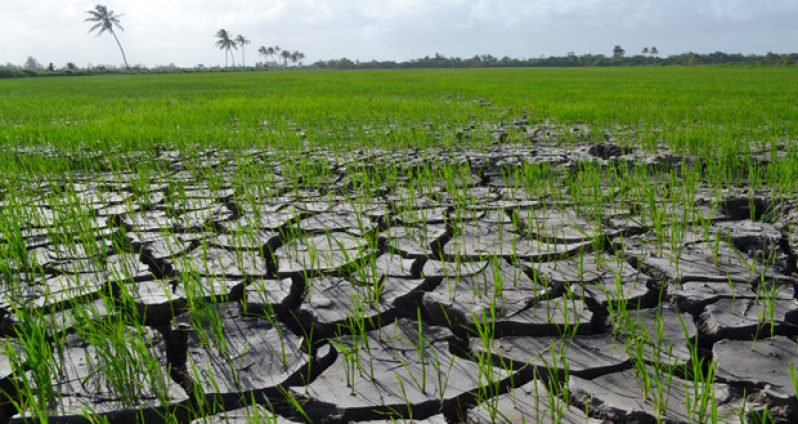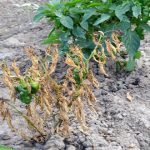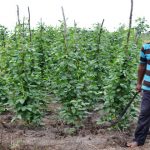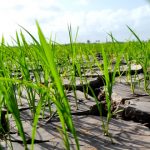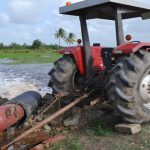HANDSOME Tree, Mahaica cash-crop farmer Roopnarine Gangaram stood Tuesday in his dying patch of 900 sweet-pepper seedlings and watched helplessy as the dry El Ni?o weather conditions continue to severely impact farming activities in the communities there. While the Mahaica/Mahaicony/Abary Agricultural Development Authority (MMA/ADA) has been providing assistance to farmers in the area via irrigation pumps near Big Baiabu and north of the area, the cash-crop farms have been bearing the brunt of the dry weather phenomenon, with some farmers already foreseeing severe losses, even as the crops stand on the beds.
At the moment, several farms and rice fields have dried up, while farmers are optimistic that the rains would ease their woes. Ironically, the communities have in the past felt the effects of flooded waters through waters released from the East Demerara Water conservancy (EDWC) whenever that water holding area reaches its optimum. However, in recent weeks the situation has completely swung, as dried weather conditions have resulted in a drop in fresh water supply for the plants there.
Gangaram told this newspaper during a visit to Handsome Tree Tuesday that he has lost large amounts of bora and sweet peppers since the weather conditions changed in mid-2015. He said that there has not been any persistent rainfall in the area for a number of weeks. “We had rains around Christmas-time, in-and-out, in-and out,” he said.
SALT-WATER FEAR
He noted that while water was being released to the area via the highlands near the Mahaica Creek passing through Handsome Tree, when the tide changes, there is a fear among farmers that the salt-rich sea water may enter the waterway. “I have some pipes which run to the farmland, and they are connected to the Creek. But right now, we think it ain’t safe to use,” Gangaram noted.
He said that he dug a reservoir near his farm, which collects rain water; and this is what he uses to water his crops. Gangaram said that his rice lands, which lay across the public road, passing through Handsome Tree is feeling the brunt of the dry weather. “Right now, over deh dry,” he said. He noted that some of the rice plants have already indicated signs of dryness.
Further down the road at Big Baiabu, Ramkarran, an elderly farmer, was awaiting a buyer who was passing through the communities, purchasing vegetables and other perishables from the farmers to re-sell at the city markets.
Ramkarran said he has lost a number of plants, including calalloo, carilla and bora. He said that his squash plants have survived the prevailing dry conditions; however, the quality of the crops may not be 100%. “I have the normal squash and the hybrid; the hybrid losing to the weather,” he noted.
Ramkarran said that he has replanted crops in another section of his farmland and he is counting on those crops to reach their optimum growth levels. “The carilla over in that section should grow enough to sell “, he said, as he pointed to another section of his farmlands.
ROUND-THE-CLOCK
Meanwhile, several tractor driven pumps were operating overtime as the rice farmers were working around-the-clock to protect their crops along the Mahaica Creek. Along the roadway, swathes of rice lands bore dry cracks, evidence of the dry weather’s severity.
One rice farmer at Little Baiabu told this newspaper that he has been monitoring the water conditions in the area, and he is optimistic that conditions will change in the coming weeks. “We have some rains now-and-then; so I hoping for the better,” he said.
The communities in the Mahaica /Mahaicony area have been essential providers of cash-crops to the city markets. Rice farms in the area have also contributed to the national rice quotas over the years.
However, unfavourable weather conditions have been the major bugbear facing the farmers in those communities, and on Tuesday, farmers who spoke to this newspaper were calling on the authorities to put more effective measures into action to assist their fading crops.
MARKED DROP
The El Ni?o dry weather conditions have resulted in a marked drop in the water level in various parts of the county. Rainfall figures indicate that the weather pattern changed significantly around July-August last year and regional reports have indicated that the trend can stretch into the second quarter of this year.
Last week, the Guyana Water Inc. (GWI) issued a call for citizens to conserve water, with the levels in the water conservancies dropping due to the prolonged dry season. At the moment, the EDWC which stores water to irrigate farmlands on the East Coast and water for GWI’s Shelter Belt location in Georgetown is at a critical level.
The EDWC is replenished by rainfall, but with the current dry spell the drainage authorities have begun collaborating to commence 24-hour pumping of water from Maduni – another surface water canal – into the EDWC.
By Alva Solomon



.jpg)




